Biology Assignment: Special Senses, Cardiovascular System & Immunity
VerifiedAdded on 2022/08/14
|18
|3520
|16
Homework Assignment
AI Summary
This Biology assignment solution encompasses four lectures. Lecture 1 focuses on the special sense of hearing, addressing the structures of the ear, the mechanics of sound vibration transmission, and potential causes of imbalance. Lecture 2 shifts to the sense of vision, detailing the structures of the eye, the function of extraocular muscles, and the roles of retinal layers and photoreceptor cells. Lecture 3 transitions to the cardiovascular system, explaining closed circulatory systems, cardiac conduction, and the structural differences between 3 and 4 chambered hearts. Finally, lecture 4 delves into the electrical and mechanical events of the heart, exploring the significance of electrocardiograms (ECGs), the cardiac cycle (systole and diastole), treatments for aortic valve stenosis, and the flow of blood through the heart during the cardiac cycle.
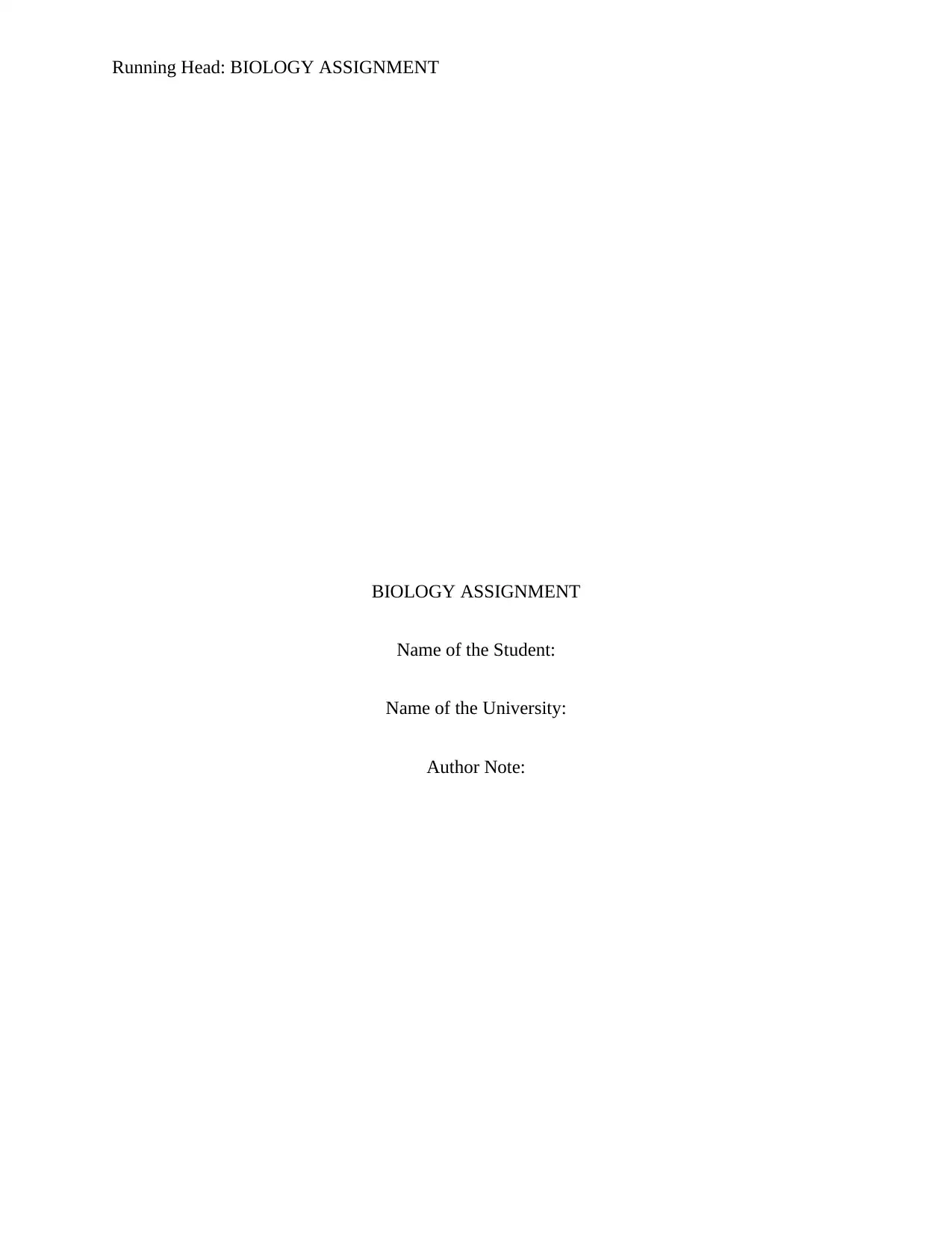
Running Head: BIOLOGY ASSIGNMENT
BIOLOGY ASSIGNMENT
Name of the Student:
Name of the University:
Author Note:
BIOLOGY ASSIGNMENT
Name of the Student:
Name of the University:
Author Note:
Paraphrase This Document
Need a fresh take? Get an instant paraphrase of this document with our AI Paraphraser
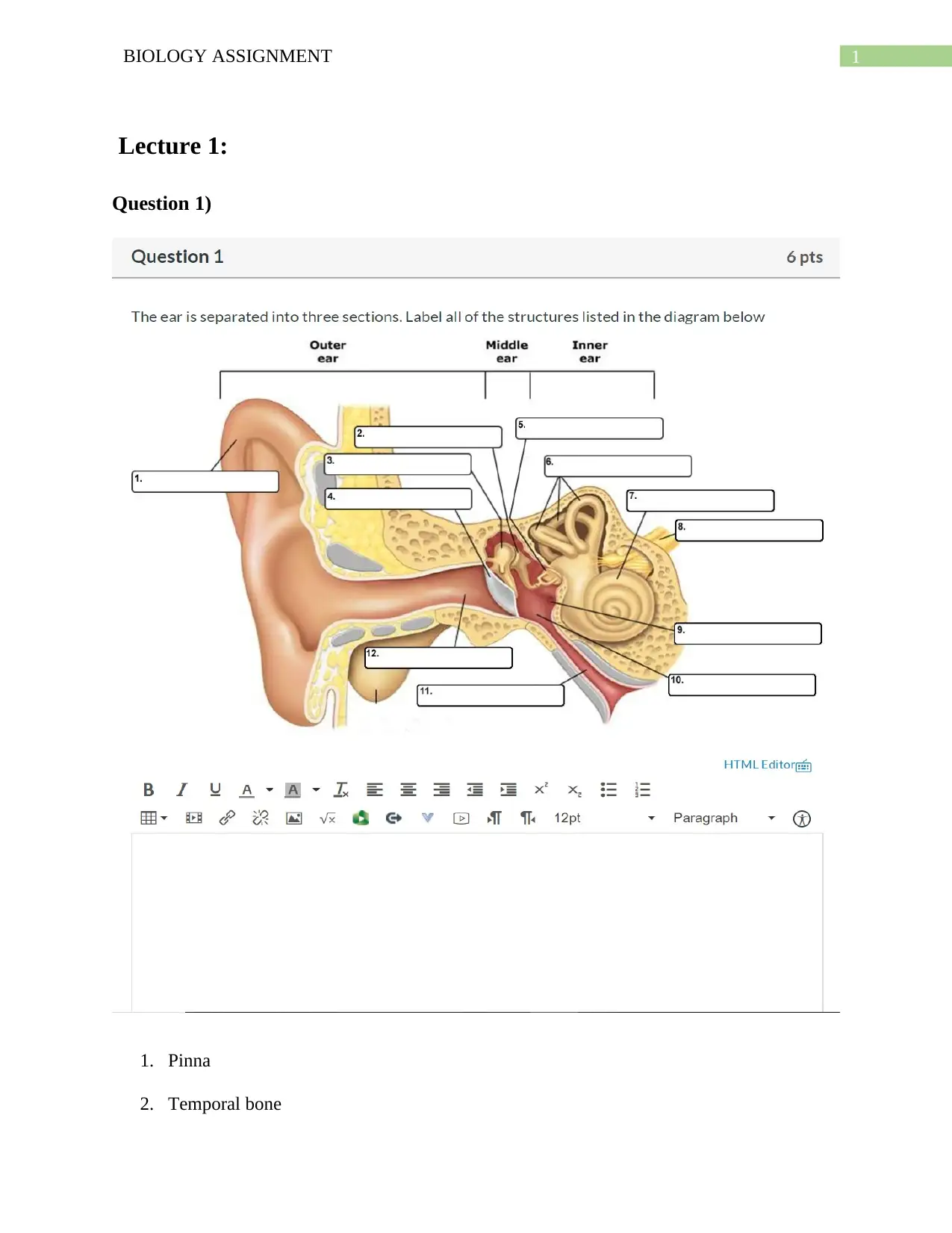
1BIOLOGY ASSIGNMENT
Lecture 1:
Question 1)
1. Pinna
2. Temporal bone
Lecture 1:
Question 1)
1. Pinna
2. Temporal bone
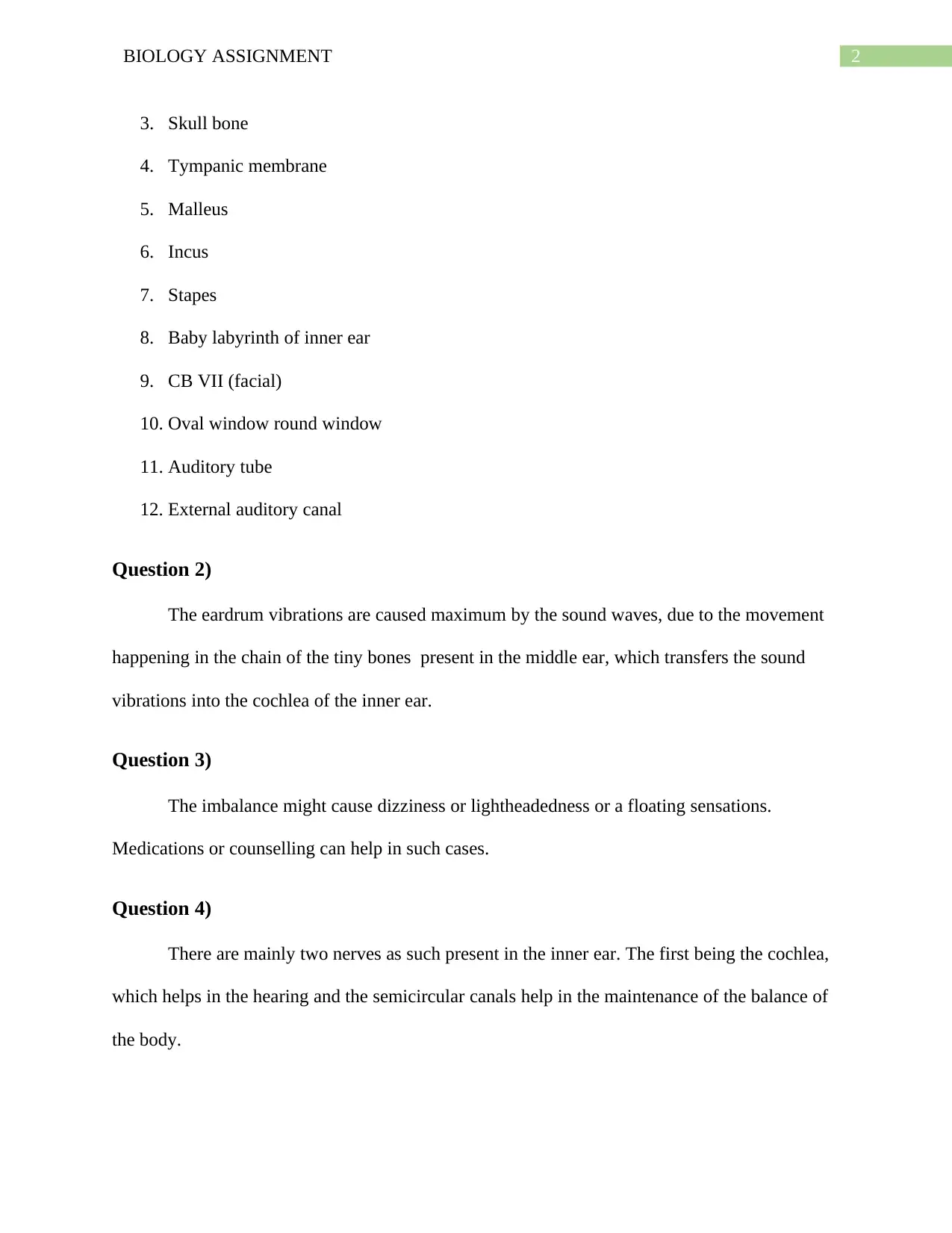
2BIOLOGY ASSIGNMENT
3. Skull bone
4. Tympanic membrane
5. Malleus
6. Incus
7. Stapes
8. Baby labyrinth of inner ear
9. CB VII (facial)
10. Oval window round window
11. Auditory tube
12. External auditory canal
Question 2)
The eardrum vibrations are caused maximum by the sound waves, due to the movement
happening in the chain of the tiny bones present in the middle ear, which transfers the sound
vibrations into the cochlea of the inner ear.
Question 3)
The imbalance might cause dizziness or lightheadedness or a floating sensations.
Medications or counselling can help in such cases.
Question 4)
There are mainly two nerves as such present in the inner ear. The first being the cochlea,
which helps in the hearing and the semicircular canals help in the maintenance of the balance of
the body.
3. Skull bone
4. Tympanic membrane
5. Malleus
6. Incus
7. Stapes
8. Baby labyrinth of inner ear
9. CB VII (facial)
10. Oval window round window
11. Auditory tube
12. External auditory canal
Question 2)
The eardrum vibrations are caused maximum by the sound waves, due to the movement
happening in the chain of the tiny bones present in the middle ear, which transfers the sound
vibrations into the cochlea of the inner ear.
Question 3)
The imbalance might cause dizziness or lightheadedness or a floating sensations.
Medications or counselling can help in such cases.
Question 4)
There are mainly two nerves as such present in the inner ear. The first being the cochlea,
which helps in the hearing and the semicircular canals help in the maintenance of the balance of
the body.
⊘ This is a preview!⊘
Do you want full access?
Subscribe today to unlock all pages.

Trusted by 1+ million students worldwide
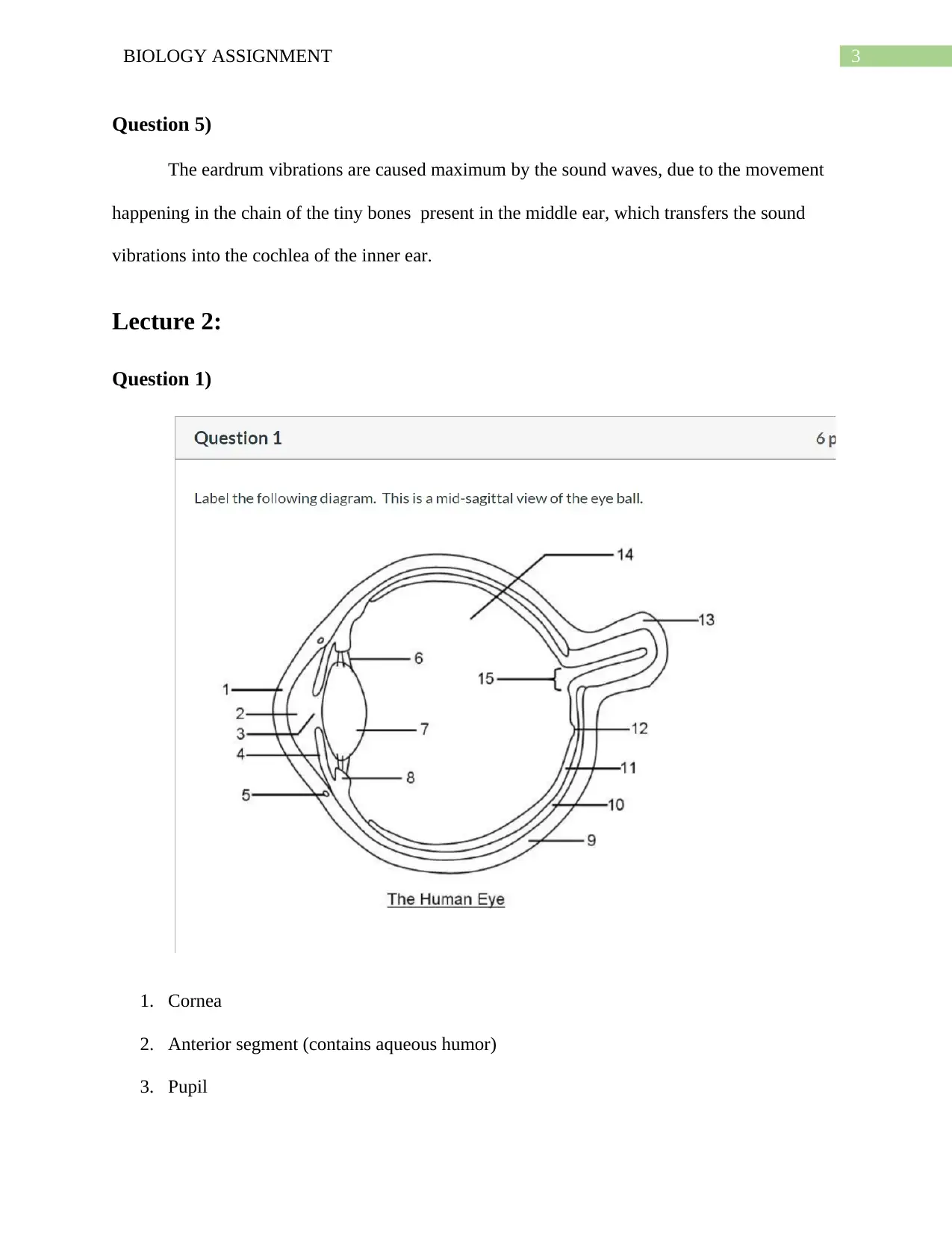
3BIOLOGY ASSIGNMENT
Question 5)
The eardrum vibrations are caused maximum by the sound waves, due to the movement
happening in the chain of the tiny bones present in the middle ear, which transfers the sound
vibrations into the cochlea of the inner ear.
Lecture 2:
Question 1)
1. Cornea
2. Anterior segment (contains aqueous humor)
3. Pupil
Question 5)
The eardrum vibrations are caused maximum by the sound waves, due to the movement
happening in the chain of the tiny bones present in the middle ear, which transfers the sound
vibrations into the cochlea of the inner ear.
Lecture 2:
Question 1)
1. Cornea
2. Anterior segment (contains aqueous humor)
3. Pupil
Paraphrase This Document
Need a fresh take? Get an instant paraphrase of this document with our AI Paraphraser
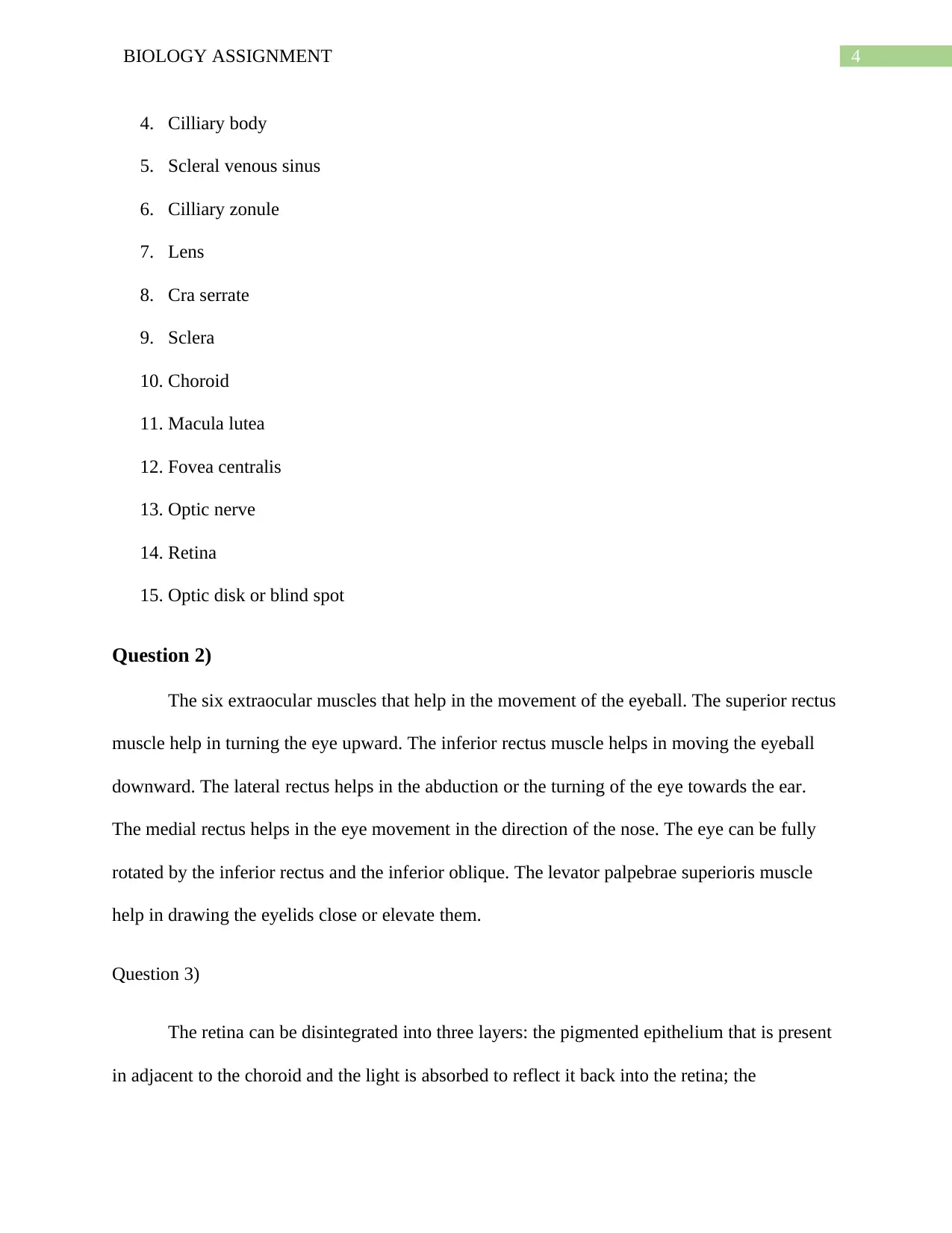
4BIOLOGY ASSIGNMENT
4. Cilliary body
5. Scleral venous sinus
6. Cilliary zonule
7. Lens
8. Cra serrate
9. Sclera
10. Choroid
11. Macula lutea
12. Fovea centralis
13. Optic nerve
14. Retina
15. Optic disk or blind spot
Question 2)
The six extraocular muscles that help in the movement of the eyeball. The superior rectus
muscle help in turning the eye upward. The inferior rectus muscle helps in moving the eyeball
downward. The lateral rectus helps in the abduction or the turning of the eye towards the ear.
The medial rectus helps in the eye movement in the direction of the nose. The eye can be fully
rotated by the inferior rectus and the inferior oblique. The levator palpebrae superioris muscle
help in drawing the eyelids close or elevate them.
Question 3)
The retina can be disintegrated into three layers: the pigmented epithelium that is present
in adjacent to the choroid and the light is absorbed to reflect it back into the retina; the
4. Cilliary body
5. Scleral venous sinus
6. Cilliary zonule
7. Lens
8. Cra serrate
9. Sclera
10. Choroid
11. Macula lutea
12. Fovea centralis
13. Optic nerve
14. Retina
15. Optic disk or blind spot
Question 2)
The six extraocular muscles that help in the movement of the eyeball. The superior rectus
muscle help in turning the eye upward. The inferior rectus muscle helps in moving the eyeball
downward. The lateral rectus helps in the abduction or the turning of the eye towards the ear.
The medial rectus helps in the eye movement in the direction of the nose. The eye can be fully
rotated by the inferior rectus and the inferior oblique. The levator palpebrae superioris muscle
help in drawing the eyelids close or elevate them.
Question 3)
The retina can be disintegrated into three layers: the pigmented epithelium that is present
in adjacent to the choroid and the light is absorbed to reflect it back into the retina; the
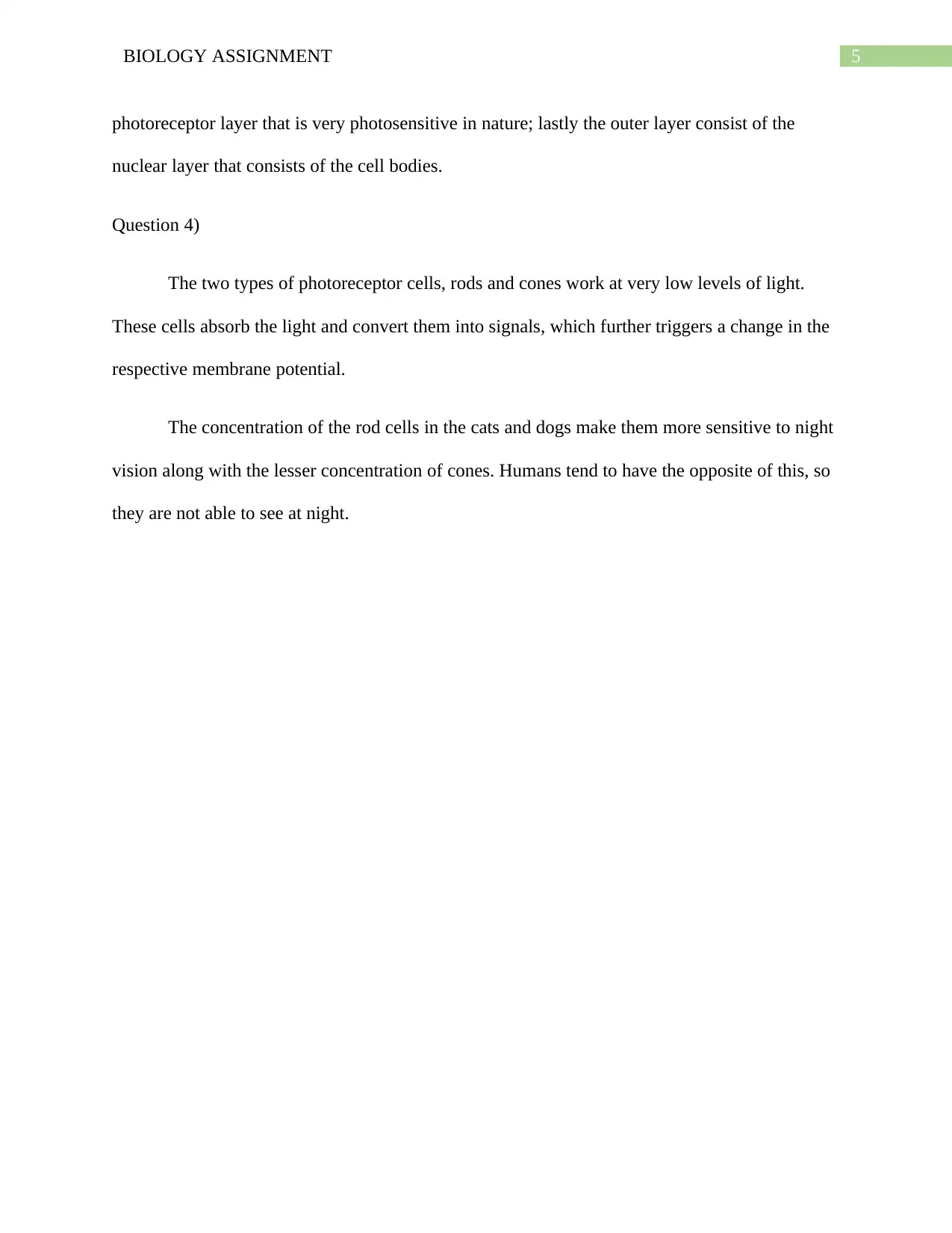
5BIOLOGY ASSIGNMENT
photoreceptor layer that is very photosensitive in nature; lastly the outer layer consist of the
nuclear layer that consists of the cell bodies.
Question 4)
The two types of photoreceptor cells, rods and cones work at very low levels of light.
These cells absorb the light and convert them into signals, which further triggers a change in the
respective membrane potential.
The concentration of the rod cells in the cats and dogs make them more sensitive to night
vision along with the lesser concentration of cones. Humans tend to have the opposite of this, so
they are not able to see at night.
photoreceptor layer that is very photosensitive in nature; lastly the outer layer consist of the
nuclear layer that consists of the cell bodies.
Question 4)
The two types of photoreceptor cells, rods and cones work at very low levels of light.
These cells absorb the light and convert them into signals, which further triggers a change in the
respective membrane potential.
The concentration of the rod cells in the cats and dogs make them more sensitive to night
vision along with the lesser concentration of cones. Humans tend to have the opposite of this, so
they are not able to see at night.
⊘ This is a preview!⊘
Do you want full access?
Subscribe today to unlock all pages.

Trusted by 1+ million students worldwide
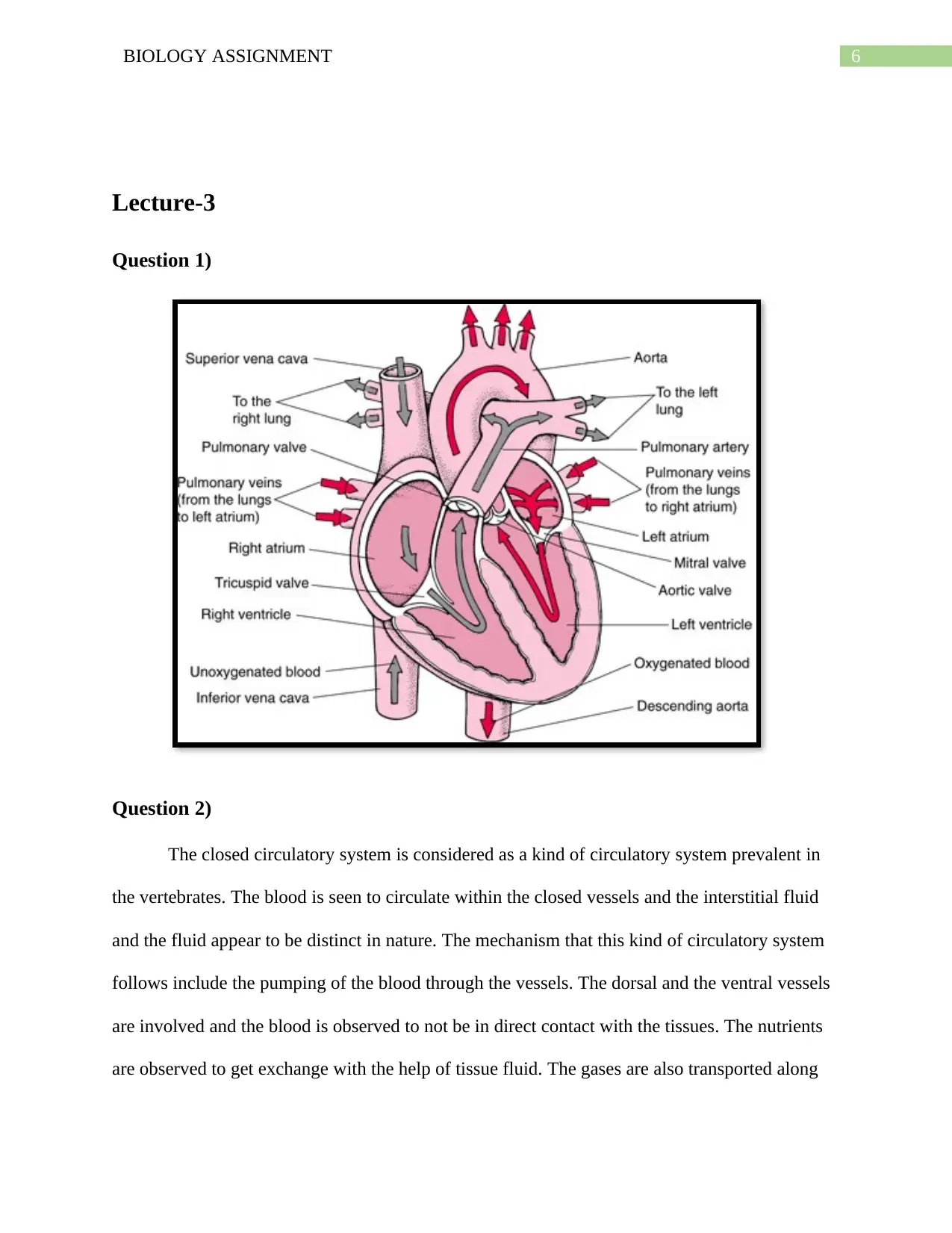
6BIOLOGY ASSIGNMENT
Lecture-3
Question 1)
Question 2)
The closed circulatory system is considered as a kind of circulatory system prevalent in
the vertebrates. The blood is seen to circulate within the closed vessels and the interstitial fluid
and the fluid appear to be distinct in nature. The mechanism that this kind of circulatory system
follows include the pumping of the blood through the vessels. The dorsal and the ventral vessels
are involved and the blood is observed to not be in direct contact with the tissues. The nutrients
are observed to get exchange with the help of tissue fluid. The gases are also transported along
Lecture-3
Question 1)
Question 2)
The closed circulatory system is considered as a kind of circulatory system prevalent in
the vertebrates. The blood is seen to circulate within the closed vessels and the interstitial fluid
and the fluid appear to be distinct in nature. The mechanism that this kind of circulatory system
follows include the pumping of the blood through the vessels. The dorsal and the ventral vessels
are involved and the blood is observed to not be in direct contact with the tissues. The nutrients
are observed to get exchange with the help of tissue fluid. The gases are also transported along
Paraphrase This Document
Need a fresh take? Get an instant paraphrase of this document with our AI Paraphraser
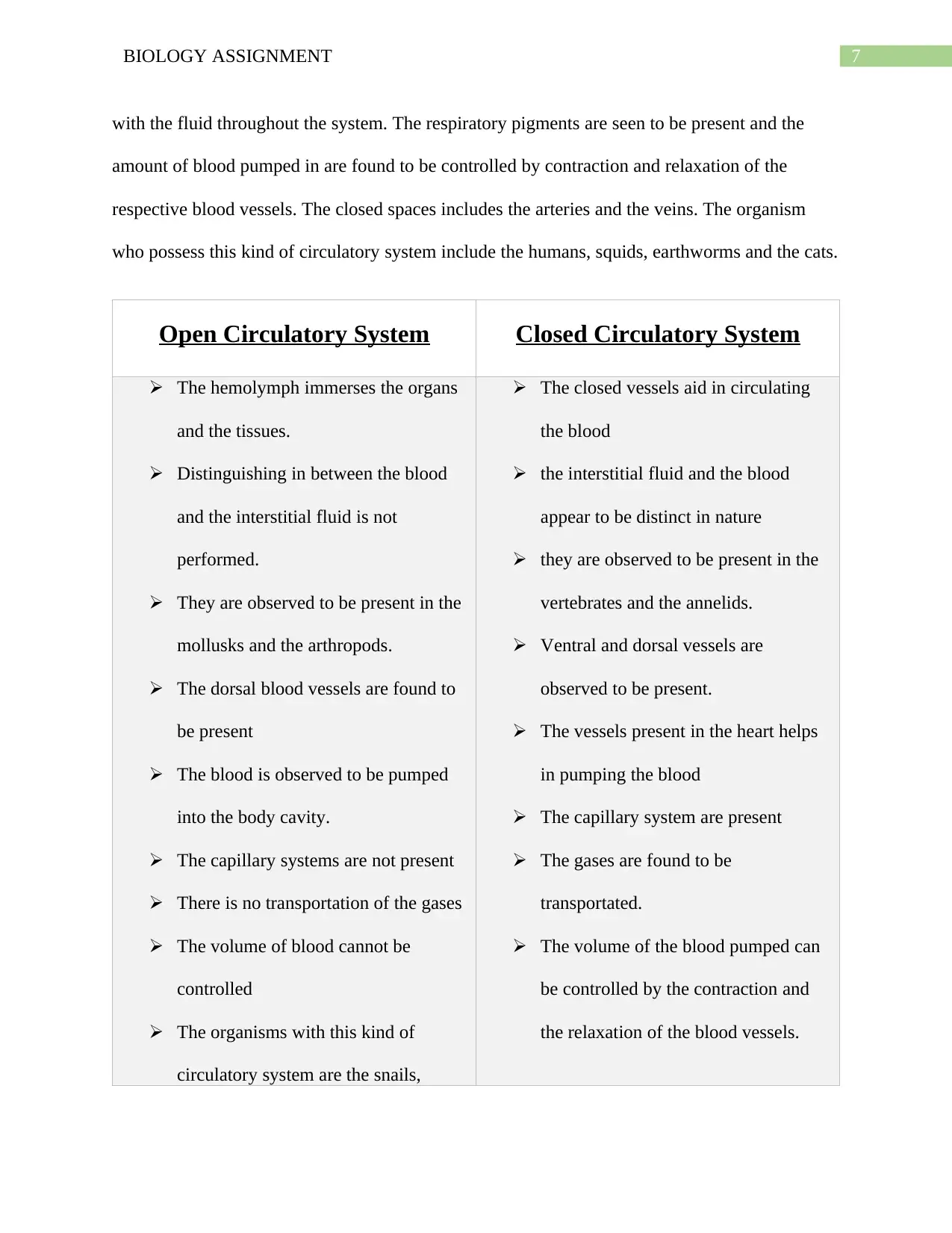
7BIOLOGY ASSIGNMENT
with the fluid throughout the system. The respiratory pigments are seen to be present and the
amount of blood pumped in are found to be controlled by contraction and relaxation of the
respective blood vessels. The closed spaces includes the arteries and the veins. The organism
who possess this kind of circulatory system include the humans, squids, earthworms and the cats.
Open Circulatory System Closed Circulatory System
The hemolymph immerses the organs
and the tissues.
Distinguishing in between the blood
and the interstitial fluid is not
performed.
They are observed to be present in the
mollusks and the arthropods.
The dorsal blood vessels are found to
be present
The blood is observed to be pumped
into the body cavity.
The capillary systems are not present
There is no transportation of the gases
The volume of blood cannot be
controlled
The organisms with this kind of
circulatory system are the snails,
The closed vessels aid in circulating
the blood
the interstitial fluid and the blood
appear to be distinct in nature
they are observed to be present in the
vertebrates and the annelids.
Ventral and dorsal vessels are
observed to be present.
The vessels present in the heart helps
in pumping the blood
The capillary system are present
The gases are found to be
transportated.
The volume of the blood pumped can
be controlled by the contraction and
the relaxation of the blood vessels.
with the fluid throughout the system. The respiratory pigments are seen to be present and the
amount of blood pumped in are found to be controlled by contraction and relaxation of the
respective blood vessels. The closed spaces includes the arteries and the veins. The organism
who possess this kind of circulatory system include the humans, squids, earthworms and the cats.
Open Circulatory System Closed Circulatory System
The hemolymph immerses the organs
and the tissues.
Distinguishing in between the blood
and the interstitial fluid is not
performed.
They are observed to be present in the
mollusks and the arthropods.
The dorsal blood vessels are found to
be present
The blood is observed to be pumped
into the body cavity.
The capillary systems are not present
There is no transportation of the gases
The volume of blood cannot be
controlled
The organisms with this kind of
circulatory system are the snails,
The closed vessels aid in circulating
the blood
the interstitial fluid and the blood
appear to be distinct in nature
they are observed to be present in the
vertebrates and the annelids.
Ventral and dorsal vessels are
observed to be present.
The vessels present in the heart helps
in pumping the blood
The capillary system are present
The gases are found to be
transportated.
The volume of the blood pumped can
be controlled by the contraction and
the relaxation of the blood vessels.
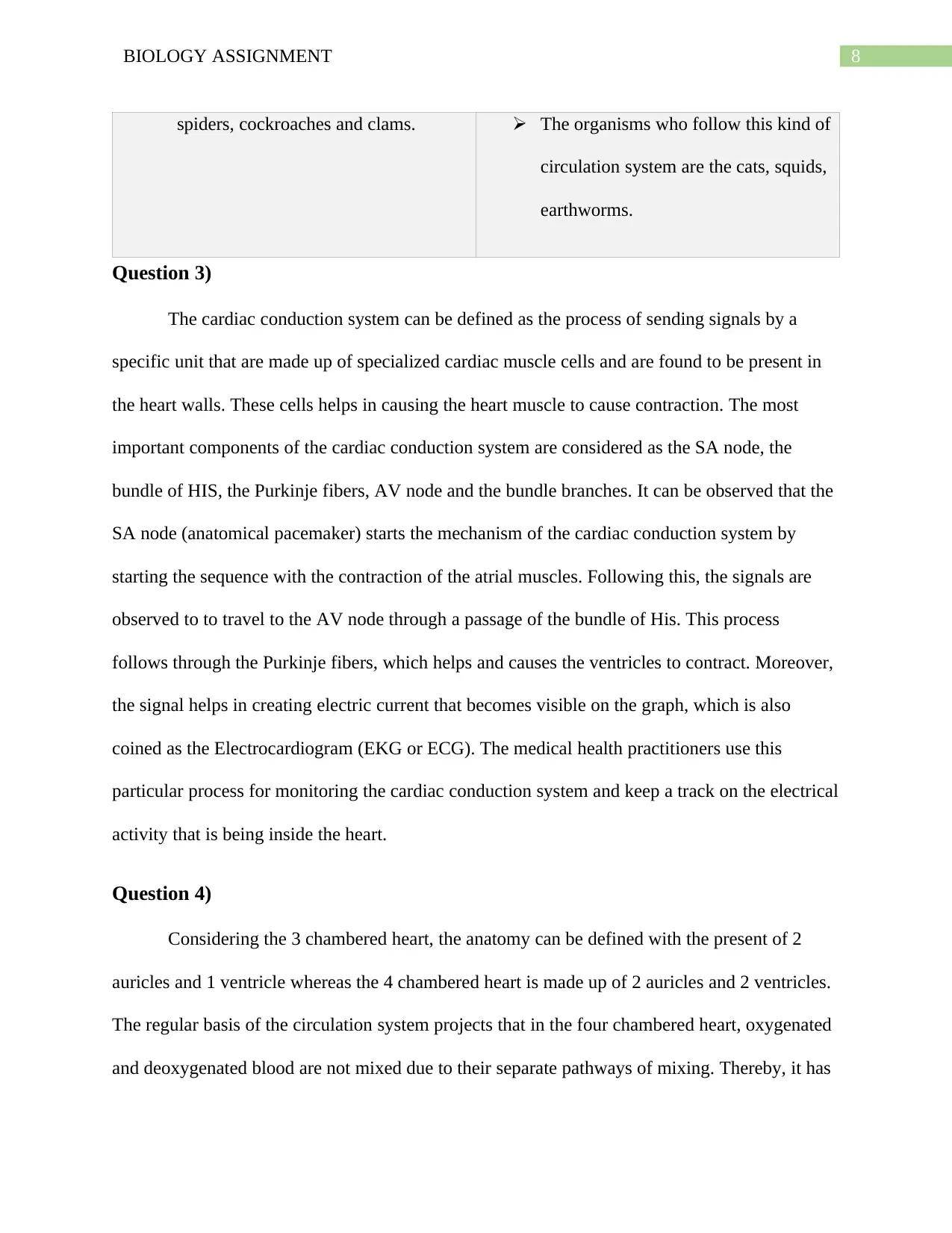
8BIOLOGY ASSIGNMENT
spiders, cockroaches and clams. The organisms who follow this kind of
circulation system are the cats, squids,
earthworms.
Question 3)
The cardiac conduction system can be defined as the process of sending signals by a
specific unit that are made up of specialized cardiac muscle cells and are found to be present in
the heart walls. These cells helps in causing the heart muscle to cause contraction. The most
important components of the cardiac conduction system are considered as the SA node, the
bundle of HIS, the Purkinje fibers, AV node and the bundle branches. It can be observed that the
SA node (anatomical pacemaker) starts the mechanism of the cardiac conduction system by
starting the sequence with the contraction of the atrial muscles. Following this, the signals are
observed to to travel to the AV node through a passage of the bundle of His. This process
follows through the Purkinje fibers, which helps and causes the ventricles to contract. Moreover,
the signal helps in creating electric current that becomes visible on the graph, which is also
coined as the Electrocardiogram (EKG or ECG). The medical health practitioners use this
particular process for monitoring the cardiac conduction system and keep a track on the electrical
activity that is being inside the heart.
Question 4)
Considering the 3 chambered heart, the anatomy can be defined with the present of 2
auricles and 1 ventricle whereas the 4 chambered heart is made up of 2 auricles and 2 ventricles.
The regular basis of the circulation system projects that in the four chambered heart, oxygenated
and deoxygenated blood are not mixed due to their separate pathways of mixing. Thereby, it has
spiders, cockroaches and clams. The organisms who follow this kind of
circulation system are the cats, squids,
earthworms.
Question 3)
The cardiac conduction system can be defined as the process of sending signals by a
specific unit that are made up of specialized cardiac muscle cells and are found to be present in
the heart walls. These cells helps in causing the heart muscle to cause contraction. The most
important components of the cardiac conduction system are considered as the SA node, the
bundle of HIS, the Purkinje fibers, AV node and the bundle branches. It can be observed that the
SA node (anatomical pacemaker) starts the mechanism of the cardiac conduction system by
starting the sequence with the contraction of the atrial muscles. Following this, the signals are
observed to to travel to the AV node through a passage of the bundle of His. This process
follows through the Purkinje fibers, which helps and causes the ventricles to contract. Moreover,
the signal helps in creating electric current that becomes visible on the graph, which is also
coined as the Electrocardiogram (EKG or ECG). The medical health practitioners use this
particular process for monitoring the cardiac conduction system and keep a track on the electrical
activity that is being inside the heart.
Question 4)
Considering the 3 chambered heart, the anatomy can be defined with the present of 2
auricles and 1 ventricle whereas the 4 chambered heart is made up of 2 auricles and 2 ventricles.
The regular basis of the circulation system projects that in the four chambered heart, oxygenated
and deoxygenated blood are not mixed due to their separate pathways of mixing. Thereby, it has
⊘ This is a preview!⊘
Do you want full access?
Subscribe today to unlock all pages.

Trusted by 1+ million students worldwide
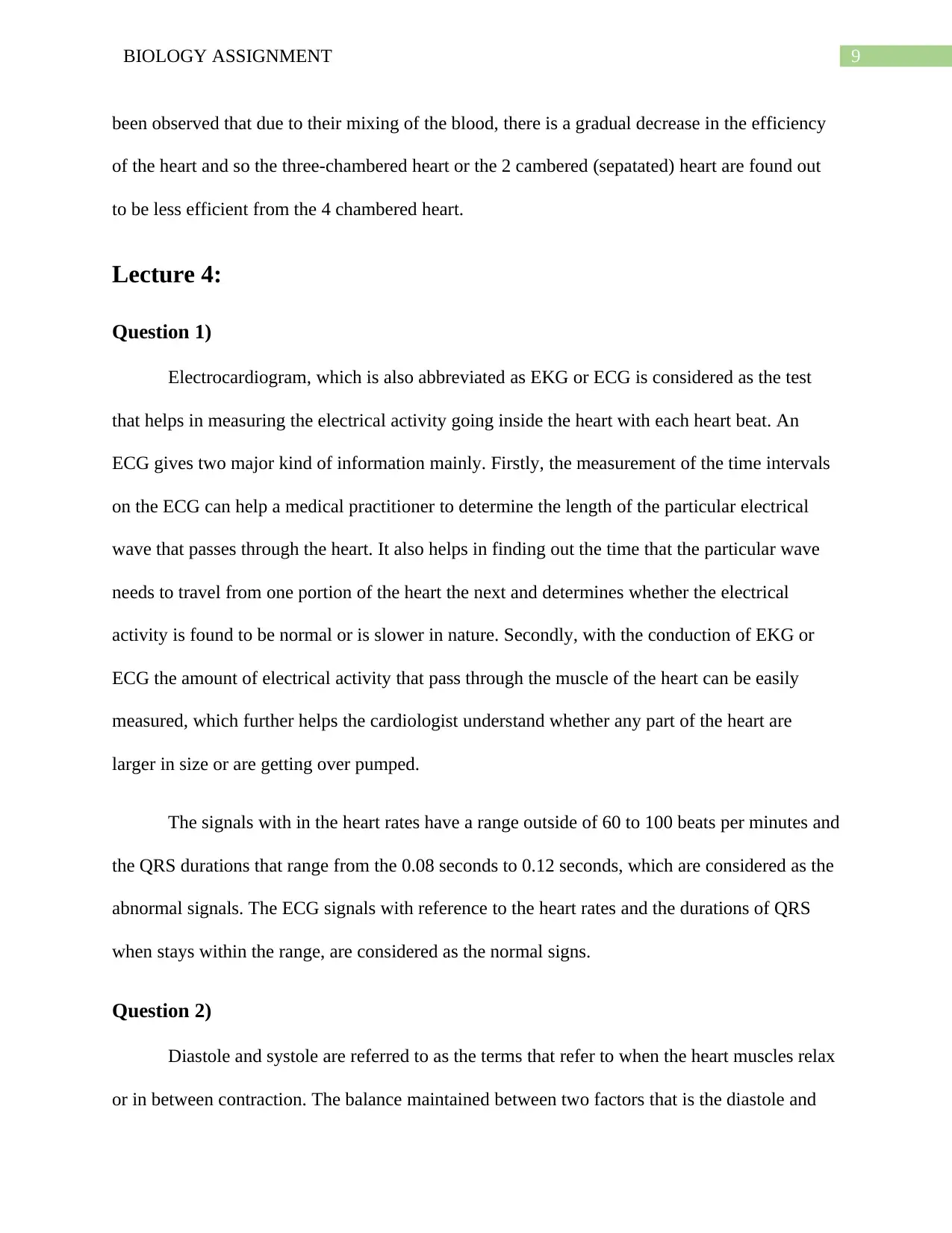
9BIOLOGY ASSIGNMENT
been observed that due to their mixing of the blood, there is a gradual decrease in the efficiency
of the heart and so the three-chambered heart or the 2 cambered (sepatated) heart are found out
to be less efficient from the 4 chambered heart.
Lecture 4:
Question 1)
Electrocardiogram, which is also abbreviated as EKG or ECG is considered as the test
that helps in measuring the electrical activity going inside the heart with each heart beat. An
ECG gives two major kind of information mainly. Firstly, the measurement of the time intervals
on the ECG can help a medical practitioner to determine the length of the particular electrical
wave that passes through the heart. It also helps in finding out the time that the particular wave
needs to travel from one portion of the heart the next and determines whether the electrical
activity is found to be normal or is slower in nature. Secondly, with the conduction of EKG or
ECG the amount of electrical activity that pass through the muscle of the heart can be easily
measured, which further helps the cardiologist understand whether any part of the heart are
larger in size or are getting over pumped.
The signals with in the heart rates have a range outside of 60 to 100 beats per minutes and
the QRS durations that range from the 0.08 seconds to 0.12 seconds, which are considered as the
abnormal signals. The ECG signals with reference to the heart rates and the durations of QRS
when stays within the range, are considered as the normal signs.
Question 2)
Diastole and systole are referred to as the terms that refer to when the heart muscles relax
or in between contraction. The balance maintained between two factors that is the diastole and
been observed that due to their mixing of the blood, there is a gradual decrease in the efficiency
of the heart and so the three-chambered heart or the 2 cambered (sepatated) heart are found out
to be less efficient from the 4 chambered heart.
Lecture 4:
Question 1)
Electrocardiogram, which is also abbreviated as EKG or ECG is considered as the test
that helps in measuring the electrical activity going inside the heart with each heart beat. An
ECG gives two major kind of information mainly. Firstly, the measurement of the time intervals
on the ECG can help a medical practitioner to determine the length of the particular electrical
wave that passes through the heart. It also helps in finding out the time that the particular wave
needs to travel from one portion of the heart the next and determines whether the electrical
activity is found to be normal or is slower in nature. Secondly, with the conduction of EKG or
ECG the amount of electrical activity that pass through the muscle of the heart can be easily
measured, which further helps the cardiologist understand whether any part of the heart are
larger in size or are getting over pumped.
The signals with in the heart rates have a range outside of 60 to 100 beats per minutes and
the QRS durations that range from the 0.08 seconds to 0.12 seconds, which are considered as the
abnormal signals. The ECG signals with reference to the heart rates and the durations of QRS
when stays within the range, are considered as the normal signs.
Question 2)
Diastole and systole are referred to as the terms that refer to when the heart muscles relax
or in between contraction. The balance maintained between two factors that is the diastole and
Paraphrase This Document
Need a fresh take? Get an instant paraphrase of this document with our AI Paraphraser
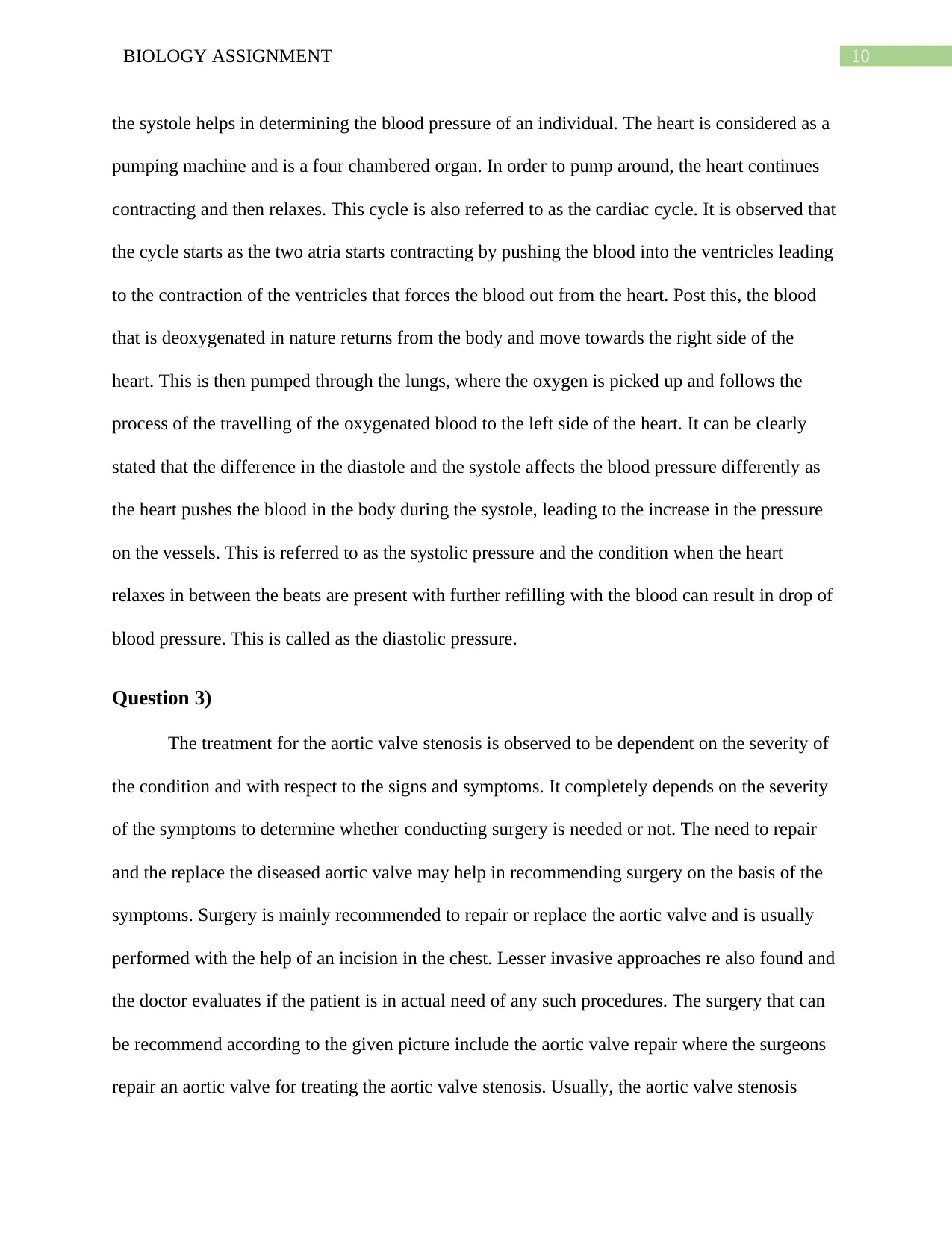
10BIOLOGY ASSIGNMENT
the systole helps in determining the blood pressure of an individual. The heart is considered as a
pumping machine and is a four chambered organ. In order to pump around, the heart continues
contracting and then relaxes. This cycle is also referred to as the cardiac cycle. It is observed that
the cycle starts as the two atria starts contracting by pushing the blood into the ventricles leading
to the contraction of the ventricles that forces the blood out from the heart. Post this, the blood
that is deoxygenated in nature returns from the body and move towards the right side of the
heart. This is then pumped through the lungs, where the oxygen is picked up and follows the
process of the travelling of the oxygenated blood to the left side of the heart. It can be clearly
stated that the difference in the diastole and the systole affects the blood pressure differently as
the heart pushes the blood in the body during the systole, leading to the increase in the pressure
on the vessels. This is referred to as the systolic pressure and the condition when the heart
relaxes in between the beats are present with further refilling with the blood can result in drop of
blood pressure. This is called as the diastolic pressure.
Question 3)
The treatment for the aortic valve stenosis is observed to be dependent on the severity of
the condition and with respect to the signs and symptoms. It completely depends on the severity
of the symptoms to determine whether conducting surgery is needed or not. The need to repair
and the replace the diseased aortic valve may help in recommending surgery on the basis of the
symptoms. Surgery is mainly recommended to repair or replace the aortic valve and is usually
performed with the help of an incision in the chest. Lesser invasive approaches re also found and
the doctor evaluates if the patient is in actual need of any such procedures. The surgery that can
be recommend according to the given picture include the aortic valve repair where the surgeons
repair an aortic valve for treating the aortic valve stenosis. Usually, the aortic valve stenosis
the systole helps in determining the blood pressure of an individual. The heart is considered as a
pumping machine and is a four chambered organ. In order to pump around, the heart continues
contracting and then relaxes. This cycle is also referred to as the cardiac cycle. It is observed that
the cycle starts as the two atria starts contracting by pushing the blood into the ventricles leading
to the contraction of the ventricles that forces the blood out from the heart. Post this, the blood
that is deoxygenated in nature returns from the body and move towards the right side of the
heart. This is then pumped through the lungs, where the oxygen is picked up and follows the
process of the travelling of the oxygenated blood to the left side of the heart. It can be clearly
stated that the difference in the diastole and the systole affects the blood pressure differently as
the heart pushes the blood in the body during the systole, leading to the increase in the pressure
on the vessels. This is referred to as the systolic pressure and the condition when the heart
relaxes in between the beats are present with further refilling with the blood can result in drop of
blood pressure. This is called as the diastolic pressure.
Question 3)
The treatment for the aortic valve stenosis is observed to be dependent on the severity of
the condition and with respect to the signs and symptoms. It completely depends on the severity
of the symptoms to determine whether conducting surgery is needed or not. The need to repair
and the replace the diseased aortic valve may help in recommending surgery on the basis of the
symptoms. Surgery is mainly recommended to repair or replace the aortic valve and is usually
performed with the help of an incision in the chest. Lesser invasive approaches re also found and
the doctor evaluates if the patient is in actual need of any such procedures. The surgery that can
be recommend according to the given picture include the aortic valve repair where the surgeons
repair an aortic valve for treating the aortic valve stenosis. Usually, the aortic valve stenosis
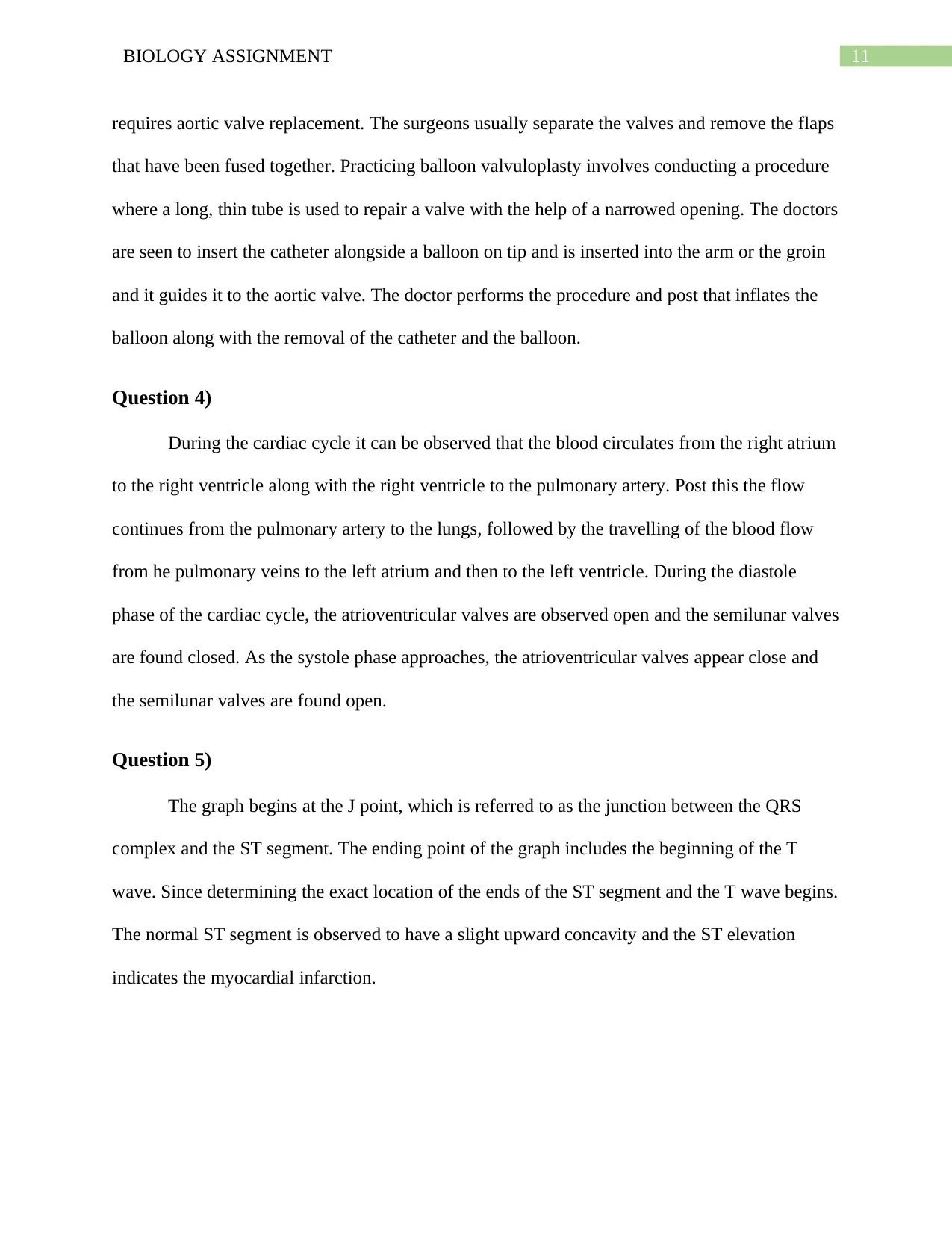
11BIOLOGY ASSIGNMENT
requires aortic valve replacement. The surgeons usually separate the valves and remove the flaps
that have been fused together. Practicing balloon valvuloplasty involves conducting a procedure
where a long, thin tube is used to repair a valve with the help of a narrowed opening. The doctors
are seen to insert the catheter alongside a balloon on tip and is inserted into the arm or the groin
and it guides it to the aortic valve. The doctor performs the procedure and post that inflates the
balloon along with the removal of the catheter and the balloon.
Question 4)
During the cardiac cycle it can be observed that the blood circulates from the right atrium
to the right ventricle along with the right ventricle to the pulmonary artery. Post this the flow
continues from the pulmonary artery to the lungs, followed by the travelling of the blood flow
from he pulmonary veins to the left atrium and then to the left ventricle. During the diastole
phase of the cardiac cycle, the atrioventricular valves are observed open and the semilunar valves
are found closed. As the systole phase approaches, the atrioventricular valves appear close and
the semilunar valves are found open.
Question 5)
The graph begins at the J point, which is referred to as the junction between the QRS
complex and the ST segment. The ending point of the graph includes the beginning of the T
wave. Since determining the exact location of the ends of the ST segment and the T wave begins.
The normal ST segment is observed to have a slight upward concavity and the ST elevation
indicates the myocardial infarction.
requires aortic valve replacement. The surgeons usually separate the valves and remove the flaps
that have been fused together. Practicing balloon valvuloplasty involves conducting a procedure
where a long, thin tube is used to repair a valve with the help of a narrowed opening. The doctors
are seen to insert the catheter alongside a balloon on tip and is inserted into the arm or the groin
and it guides it to the aortic valve. The doctor performs the procedure and post that inflates the
balloon along with the removal of the catheter and the balloon.
Question 4)
During the cardiac cycle it can be observed that the blood circulates from the right atrium
to the right ventricle along with the right ventricle to the pulmonary artery. Post this the flow
continues from the pulmonary artery to the lungs, followed by the travelling of the blood flow
from he pulmonary veins to the left atrium and then to the left ventricle. During the diastole
phase of the cardiac cycle, the atrioventricular valves are observed open and the semilunar valves
are found closed. As the systole phase approaches, the atrioventricular valves appear close and
the semilunar valves are found open.
Question 5)
The graph begins at the J point, which is referred to as the junction between the QRS
complex and the ST segment. The ending point of the graph includes the beginning of the T
wave. Since determining the exact location of the ends of the ST segment and the T wave begins.
The normal ST segment is observed to have a slight upward concavity and the ST elevation
indicates the myocardial infarction.
⊘ This is a preview!⊘
Do you want full access?
Subscribe today to unlock all pages.

Trusted by 1+ million students worldwide
1 out of 18
Related Documents
Your All-in-One AI-Powered Toolkit for Academic Success.
+13062052269
info@desklib.com
Available 24*7 on WhatsApp / Email
![[object Object]](/_next/static/media/star-bottom.7253800d.svg)
Unlock your academic potential
Copyright © 2020–2025 A2Z Services. All Rights Reserved. Developed and managed by ZUCOL.